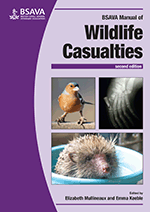
Full text loading...

The wild waterfowl species that inhabit the varied habitats of the British wetlands are diverse, including swans, geese, ducks, and grebes. Escaped or released domestic geese and ducks may also be presented, and this overlap between wild and domestic can make rehabilitation and release decisions more complicated. This chapter covers: ecology and biology; anatomy and physiology; capture, handling and transportation; clinical assessment; first aid and hospitalization; anaesthesia and analgesia; specific conditions; therapeutics; husbandry; rearing of young waterfowl; rehabilitation and release; and legal considerations.
Waterfowl, Page 1 of 1
< Previous page | Next page > /docserver/preview/fulltext/10.22233/9781910443316/9781910443316.26-1.gif

Full text loading...




















